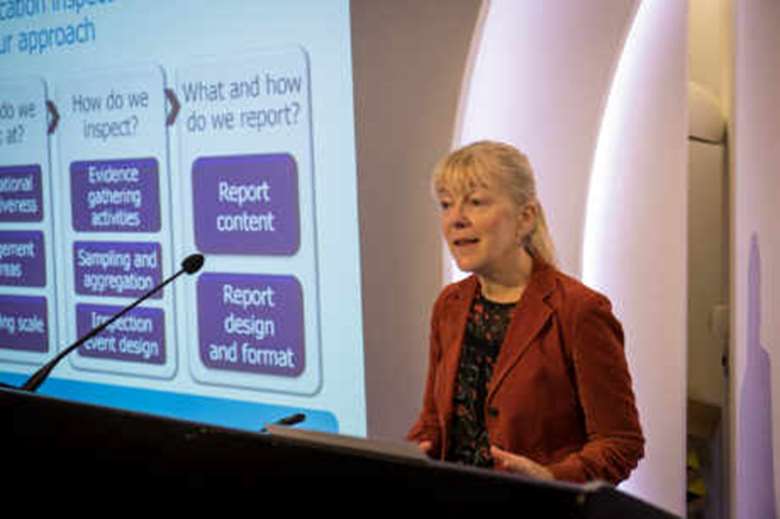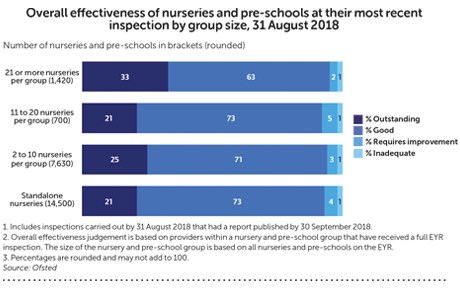Ofsted annual report: Top marks for large groups
Sunday, December 9, 2018
Nurseries and pre-schools operating in large groups have a greater proportion of Outstanding grades, Ofsted’s annual report shows.

- 95 per cent of providers judged Good or Outstanding at their most recent inspection
- Nurseries and pre-schools operating in a group more likely to be Outstanding
- Number of providers is decreasing but places are stable at around 1.3 million
Nurseries and pre-schools operating in large groups have a greater proportion of Outstanding grades, Ofsted’s annual report shows.
While the proportion of nurseries and pre-schools judged Good and Outstanding is similar across groups and those operating alone, there is ‘a notable difference’ in the proportion judged outstanding for groups of 21 or more.
These groups operate around 1,420 nurseries with a third of their settings (33 per cent) judged Outstanding and 63 per cent rated Good.
The vast majority of nurseries and pre-schools are standalone businesses – 14,500 as of 31 August. For those that fall within this category, just over a fifth (21 per cent) run provision judged Outstanding by Ofsted.
Standalone nurseries have double the proportion of settings judged to require improvement (4 per cent) than groups with 21 nurseries or more (2 per cent).

Ofsted’s annual state of the nation report shows that inspection outcomes for providers on the Early Years Register remain strong.
According to the findings, 95 per cent of nurseries and pre-schools, compared with 94 per cent of childminders, were judged Good or Outstanding at their most recent inspection.
This has increased by 1 percentage point since 31 August 2017, and is a substantial increase from 74 per cent on 31 August 2012, when Ofsted revised its previous inspections framework.
Since 2012, the proportion of childminders judged Good or Outstanding has improved at a faster rate than for nurseries or pre-schools.
Ofsted attributed the rise in the quality of the sector to a number of factors, including:
- Changes to the EYFS in 2012 mean childminders have to complete training before registering with Ofsted, which may have reduced the number of joiners but improved the quality of those joining.
- Since November 2013, Ofsted has re-inspected all nurseries and pre-schools judged to require improvement within 12 months.
- From August 2016, Ofsted has prioritised inspecting childminders previously requiring improvement.
Providers and places
There has been a fall in the total number of early years and childcare providers registered with Ofsted, a decrease of 18 per cent since August 2012.
This is due to a large decrease in childminders and a small decrease in nurseries and pre-schools (just 2 per cent).
However, Ofsted stressed that despite the fall, the number of places has remained around 1.3 million since August 2012.
Although childminder numbers have decreased by 30 per cent, the number of places they offer is down by 12 per cent, meaning that individual childminders are offering a higher number of places on average – six places, the maximum they can offer without employing any assistants.
Currently there are only a handful of childminder agencies registered with Ofsted, with only two possible inspection outcomes, ‘effective’ and ‘ineffective’. As of 31 August, six out of 11 childminder agencies had childminders on roll. All six agencies have been inspected and all were judged to be effective.
Interview
Gill Jones, deputy director, early years, Ofsted
Ofsted will announce the names of those chosen as members of the Early Years Pedagogy and Practice forum before the end of the year.
Speaking to Nursery World after the report’s launch, Gill Jones said, ‘We have a huge number of applicants, which is great and we’re going to announce who is on the core group later this month, and we’ll be looking at ways of communicating online with everyone who has applied.
‘We’re going to use that group to look at the different areas of the curriculum in preparation for the EIF, the Education inspection Framework, from September.
‘We’ve tried to be really fair in having some practitioners, some leaders, some researchers, a really good group of people. It’s really exciting. We’re going to have a really good pedagogical talk about what good early years looks like.’
Commenting on the report’s findings, she said, ‘It’s a really positive picture across the piece for early years and I think there are a couple of reasons for that – it’s ten years since the EYFS and people are getting better at delivering it and we’re seeing the impact of that. We’re also seeing the impact of the way we’re inspecting; the framework has been in now for over three years, so as people get used to it they know what to expect with inspection.’
Commenting on why larger providers are doing better, she said, ‘The big difference is that they will have flexibility in their management model and they will have enough capacity to go and work with other settings. I think there’s probably an optimum size for providers.
‘Smaller groups of providers of five or six settings tell me that it’s more difficult when they get to that sort of number because they’re big enough to want to do things as a unit, but they’re not big enough to have the extra resource. There’s a financial point at which it becomes easier to ensure that you have people who are supernumerary.
‘I do know that providers that will be included in the top bar [see chart] all have curriculum policies, health and safety policies, staff training, apprenticeships, they’re growing their own staff.’
Asked if there is anything Ofsted can do about the ongoing fall in childminders, she said, ‘We’ve done a little bit of research about why that is, because we’re concerned that we have sufficient childminder places.
‘Where we’ve had resignations, we’ve started to ask childminders why they’re resigning.
‘We asked that question because we did wonder if it was the threat of an Ofsted inspection that was causing the problem – that’s not what we found from our research. There seems to be a natural lifespan of a childminder and it seems to fit with having their own children and seeing them through to primary school.
‘There’s an average of about eight years’ childminding time. We think the issue is there’s obviously a natural wastage when it may become not as attractive for a childminder to do that role and a difficulty in recruitment because childminding agencies haven’t taken off as rapidly as the Government would have hoped.
‘We know that the number of childcare places hasn’t fallen significantly, so from our perspective there is still sufficiency – but it’s in a different way.’
Inspection framework
On the new framework, Ms Jones said, ‘There will be a full consultation in January. We have a slide share which is up on the website, the presentation that I did for the [Nursery World] Business Summit, for people to look at now. We’ve also started to do some engagement events and we’ll be doing much more of that sort of work once the consultation goes out.
‘We’ll be putting some quite detailed handbooks out so that people can see what the handbook will look like at the early stage. We have the common inspection handbook at the moment, so when we consult they’ll be seeing the new version. We’re doing this so people can really see the detail.’
Asked about the issue of obesity, and the role of parents, Jones said, ‘One of the things we look at in our inspection of providers is the quality of food. And I have to say that I think the food they have on offer is terrific, they encourage children to taste new foods. They’re very careful about diet and allergies.
‘We know in nursery provision most providers, if we’ve judged a provider Good or better, the quality of food that children are given, our evidence will tell us it’s good. Our evidence doesn’t match what we see in Reception.
‘Anecdotally when you go on a bus, you see children in push chairs with sugary drinks, sweets, McDonald’s. Our inspection evidence doesn’t tell us that, but there’s a gap between children being obese, what we’re seeing in nurseries, and what nursery leaders tell us is happening when some children are picked up from nursery.’
On whether there will be more in the new framework regarding physical development, Ms Jones commented, ‘We’re very keen that physical development means children being physical. But this is for the Department for Education to set out [in the revised goals]. We inspect currently against the EYFS and it doesn’t say much in the EYFS about physical development at the moment.’




